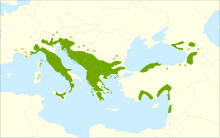| European hop-hornbeam | |
|---|---|

| |
| Scientific classification | |
| Kingdom: | Plantae |
| Clade: | Tracheophytes |
| Clade: | Angiosperms |
| Clade: | Eudicots |
| Clade: | Rosids |
| Order: | Fagales |
| Family: | Betulaceae |
| Genus: | Ostrya |
| Species: | O. carpinifolia
|
| Binomial name | |
| Ostrya carpinifolia | |

| |
| Native range | |
Ostrya carpinifolia, the European hop-hornbeam, is a tree in the family Betulaceae. It is the only species of the genus Ostrya that is native to Europe.
The specific epithet carpinifolia means "hornbeam-leaved", from carpinus, the Latin word for "hornbeam".
Common name
The name hophornbeam is derived from the ancient Greek name of a hard wood tree.[1]
Description
Ostrya carpinifolia is a broadleaf deciduous tree, that can reach up to 21 metres (69 ft).[2] It has a conical or irregular crown and a scaly, rough bark, and alternate and double-toothed birch-like leaves 3–10 cm long. The leaves are many-veined with 11-15 pairs and have a slightly hairy or smooth underside.[1]
The flowers are produced in spring, with male catkins 5–10 cm (2–4 in) long and female catkins 2–5 cm (3⁄4–2 in) long. The fruit form in pendulous clusters 3–8 cm (1+1⁄4–3+1⁄4 in) long with 6–20 seeds; each seed is a small nut 2–4 mm (1⁄16–3⁄16 in) long, fully enclosed in a bladder-like involucre.
Distribution and habitat

Ostrya carpinifolia is found in Lebanon, Italy, France, Austria, Slovenia, Albania, Croatia, Bosnia and Herzegovina, Serbia, Montenegro, North Macedonia, Greece, Bulgaria, southern Switzerland and Turkey. It has been cultivated in England since before 1724.[1]
It is found in the medium elevations, in southern Italy and Sicily, in the South Apennine mixed montane forests ecoregion of the Mediterranean forests, woodlands, and scrub Biome.

Uses
The wood is very heavy and hard, and was historically used to fashion plane soles. Other uses have included in the manufacture of wooden cogs and gears.[1]
Ostrya are used as food plants by the larvae of some Lepidoptera species.
References
- ^ a b c d Větvička, Václav. Lawrence, Eleanor (ed.). The Illustrated Book of Trees & Shrubs. Translated by Kuthan, Ivan; Kuthanová, Vlasta. Illustrated by Mašek, Jan. Octopus Books. p. 143. ISBN 0706420853.
- ^ "hop-hornbeam". Encyclopædia Britannica. Retrieved 6 May 2024.
External links
- GRIN database: Ostrya carpinifolia
- Scheda botanica: Ostrya carpinifolia
- Ostrya carpinifolia - information, genetic conservation units and related resources. European Forest Genetic Resources Programme (EUFORGEN)
